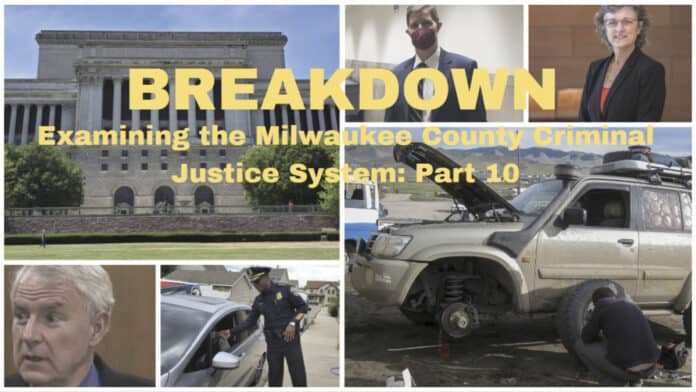PART 11 IN A 10-PART SERIES.
Milwaukee County’s criminal justice system has broken down at almost all levels.
Although some of the breakdown can be attributed to the pandemic, some can not. Local officials’ questionable policy decisions also play a role, and it’s imperiling public safety. The pandemic exacerbated some already existing trends and caused others, but officials have not developed effective strategies to recover. Some non-pandemic-related issues, like the ACLU-related Collins Agreement’s impact on proactive policing and plummeting numbers of police officers (down 26% since 1996) have been largely overlooked in the media.
PROBLEM #10: Defunding the police?
The number of sworn officers in 2022 was 1,597, down 17% from 2018, the result of budget cuts and vacant positions caused by a retirement surge, in part.
[We would note that the decrease is even worse if you go back farther. In 2021, we obtained numbers of sworn officers from MPD. We looked at the numbers going back to 1995. The highest number of sworn officers was in 1996, when there were 2,176. That means the number of sworn officers has dropped 26.6% since 1996.]
THE SERIES: We have taken the lead in exploring the problems in Milwaukee County’s Criminal Justice system, breaking stories on Milwaukee police staffing declines (which started years ago), the DA’s high non-prosecution rate and new reliance on summonses, the ACLU Collins Agreement’s deleterious effect on proactive policing, new jail and police policies restricting bookings and arrests, and the massive court backlogs, which leave defendants on the streets longer to re-offend and which provoke constitutional concerns. Milwaukee is at a crisis point, with record homicide numbers and a severe reckless driving crisis.
Now, a new August 2023 report from the Wisconsin Policy Forum has examined Milwaukee County’s Criminal Justice System in great detail, providing fresh data from 2018 (before the pandemic) to 2022. The quotes and data in the opening section come from this report with the exception of the data dating to 1996, which we obtained from MPD. We are excerpting some of the key statistical findings in a 10-part series to further understanding of the problem. You can’t formulate solutions if you don’t understand the problem’s scope. The few news articles that emerged only superficially skimmed over the report’s findings.
Although the report deals with the context of the pandemic, it also makes it clear that, in many respects, trends imperiling public safety started before it or have continued, even escalating in some cases, in 2022, after its height. In other words, you can’t blame everything on the pandemic. The report also indicates that, in a number of ways, problems that escalated during the pandemic have not been resolved by officials even as late as 2022.
PROBLEM #10: Drop in Sworn Officers
“MPD has fewer officers,” the report says. “In addition to seeing an increase in workload from greater numbers of service calls and medical runs, MPD officials cite a shrinking number of officers on the street to handle that workload as a likely contributor to the sharp drop in arrests.”
The report found:
- The number of sworn officers fell gradually throughout the 2018 to 2022 period; the department had 1,597 sworn officers (i.e. filled positions) as of the last pay period of 2022, which was 320 (17%) fewer than the number of filled officer positions as of the
last pay period of 2018.” - This reduction was a product of both budget cuts that reduced the number of sworn positions and an increased number of vacant positions caused by a surge in retirements and other factors.”
The report indicates, “Overall, MPD officials say it could be the confluence of several factors cited above and throughout this report – e.g. the reduction in sworn officers coupled with sizable increases in offenses, Priority 1 calls for service, and other workload-related factors – that has diminished the department’s ability to conduct the types of proactive activities and investigations that lead to arrests, thus causing the decline in recent years. They note further that the increase in Part I offenses includes a 36% increase in firearm-related violent offenses and a 136% increase in firearm-related homicides, and that investigations related to these types of crimes require extensive time from both patrol officers and the Criminal Investigations Bureau, thus further limiting the department’s overall capacity to make arrests.”







![Protecting Portland: No Good Deed Goes Unpunished [REVIEW]](https://www.wisconsinrightnow.com/wp-content/uploads/2025/07/portland-356x220.jpg)























